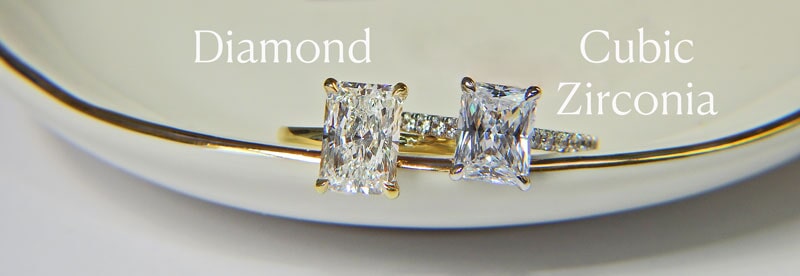What Are Simulated Diamonds?

As you anticipate the moment you hear that four-word question, you might find yourself engulfed in the wonderful world of diamonds. That world includes traditionally mined diamonds, lab-grown diamonds, and simulated diamonds. Before you say yes, having an understanding of what these are and how they differ is important - that’s why we’re breaking down simulated diamonds for you.
From compositions to quality and value, we’ll explore what simulated diamonds are to get you one step closer to finding your dream diamond engagement ring.
The Breakdown of A Simulated Diamond
You may have heard that simulated diamonds and lab grown diamonds are the same - that couldn’t be further from the truth (more on that later). Simulated diamonds are created using a variety of materials designed to mimic the appearance of natural diamonds. Those materials can include cubic zirconia (CZ), moissanite, white sapphire, or synthetic rutile.
Cubic Zirconia
Arguably the most popular of the materials, cubic zirconia is known for its affordability and diamond-like appearance. It gets its diamond-like sparkle from a synthetic crystalline substance made from zirconium dioxide.
Moissanite
Another popular choice for diamond alternatives is moissanite which is a naturally occurring mineral that creates a beautiful simulated diamond known for its durability.
White Sapphire
Composed of the mineral corundum, a crystalline form of aluminum oxide, white sapphire simulated diamonds have great clarity and facets that create the sought-after glistening effect.
Synthetic Rutile
Though the least used of the other simulated diamonds, the synthetic rutile, a lab-created material composed of titanium dioxide still packs the sparkle that you’d expect in a diamond.

So, Are They Worth It?
Now that we’ve broken down exactly what a simulated diamond is, let’s explore its value. Whether or not they are worth it comes down to your preference, budget, and maybe even your stance on simulated vs natural vs lab grown diamonds. Are they visually similar, yes. But when you look further into the differences, you’ll have the information you need to make the best decision for you.
One significant difference lies in their composition. As we broke down earlier, simulated diamonds are typically made from cubic zirconia, moissanite, white sapphire, or synthetic rutile. Natural diamonds in comparison are composed of pure carbon formed under intense pressure with the earth’s mantle. These materials matter because, other than beauty, a ring that is supposed to last a lifetime also requires durability. As far as sturdiness, when it comes to simulated diamond rings it will depend heavily on the material you choose. Compared to diamonds, they are less resistant to scratching and abrasions.
Another factor to consider when measuring value is color consistency. Because of the climate in which diamonds are created, there is a lot of free forming that takes place, resulting in a range of colors, from colorless to stunning yellows, pinks, or even blues. In comparison, simulated diamonds are created in a controlled environment where manufacturers can choose the desired color consistency. This plays a large role in the beauty, quality, and market desirability, which impacts its value.
While those factors of value can be measured down to a science, there are others that only you can measure - like sustainability.
The Difference: Simulated Diamonds vs Lab Grown Diamonds
Simulated and lab grown diamonds are both alternatives to natural diamonds but you shouldn’t confuse them as the same. From composition, production process, and value proposition, simulated and lab created diamonds are significantly different.
While simulated diamonds are composed of materials aiming to mimic the appearance of natural diamonds, they are not composed of carbon like natural diamonds. Lab grown diamonds are genuine diamonds that are simply created in a laboratory using advanced technology. They have the same chemical composition, crystal structure, and physical elements you would expect from a natural diamond. Grown from carbon atoms using high pressure and high temperatures, lab grown diamonds are valued the same as natural diamonds.
One thing to also take into consideration is the cost. While both are budget-friendly compared to natural diamonds because simulated diamond rings are synthetic gemstones, these are often the most affordable option. On the other hand, lab grown diamonds may come with a higher price tag compared to a simulated diamond, but the value is equivalent to a natural diamond.
For those in search of a more ethical choice, lab grown diamonds offer sustainable diamonds produced without the environmental and social impacts associated with diamond mining.

The Future Of Diamond Alternatives
Picture a future where you don’t have to question if your dream engagement ring was created at the expense of the environment or human rights - that’s where we believe the industry is headed. With growing awareness of environmental and ethical concerns surrounding traditional diamond mining, more and more people will turn to alternatives like simulated and lab grown diamonds.
As climate shifts towards sustainability and ethical sourcing, diamond alternatives will continue to meet the demands of the people who seek them - and that’s where Plum comes in. For years we’ve been advocates of natural diamond alternatives that put quality, communication, and ethics first. That means all of our lab created diamonds are crafted from the best materials. We’ll guide you throughout your journey, and we are committed to ethically sourcing our metals. From engagement rings to wedding bands, and everyday jewelry, everything we create is manufactured in a sustainably-driven facility certified by the Responsible Jewellery Council. Our goal is simple, create natural diamond alternatives our customers can trust.
Are you interested in learning more about the diamond alternatives that are available to you? Connect with us on Instagram, TikTok, and Facebook, or contact one of our diamond experts.











